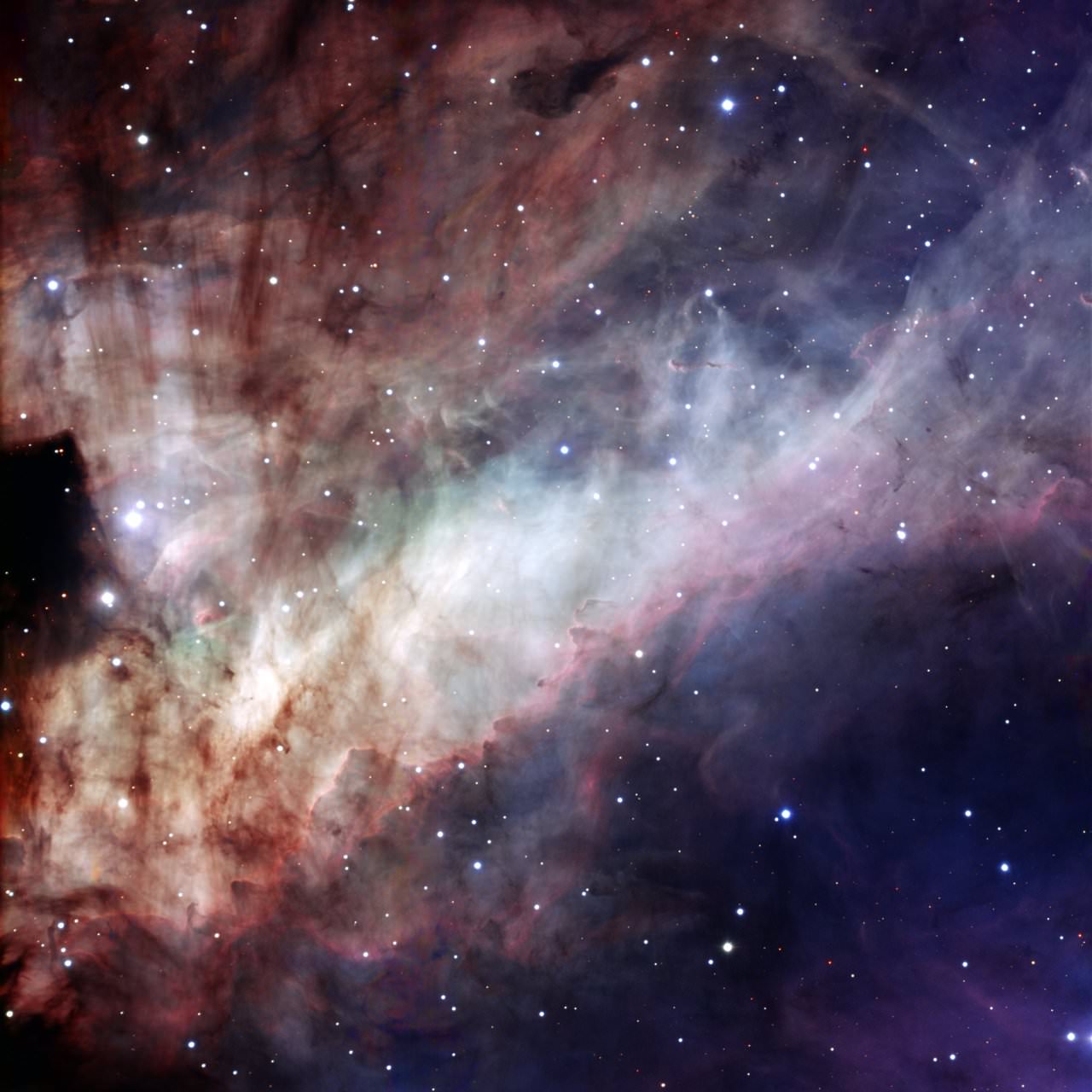[/caption]
The Omega Nebula, a stellar nursery 5500 light-years away towards the constellation Sagittarius (the Archer), is looking positively dashing in this new image released today by the European Organisation for Astronomical Research in the Southern Hemisphere (ESO). The subtle color shades across the three-color composite image comes from the presence of different gases (mostly hydrogen, but also oxygen, nitrogen and sulfur) that are glowing under the fierce ultraviolet light radiated by hot young stars.
The Omega Nebula, sometimes called the Swan Nebula, is an active star-forming region of gas and dust about 15 light-years across that has recently spawned a cluster of massive, hot stars. The intense light and strong winds from these hulking infants have carved the filigree structures in the gas and dust.
When seen through a small telescope, the nebula has a shape that reminds some observers of the final letter of the Greek alphabet, omega, while others see a swan with its distinctive long, curved neck. Other nicknames for this evocative cosmic landmark include the Horseshoe and the Lobster Nebula.
Swiss astronomer Jean-Philippe Loys de Cheseaux discovered the nebula around 1745. The French comet hunter Charles Messier independently rediscovered it about twenty years later and included it as number 17 in his famous catalogue. In a small telescope, the Omega Nebula appears as an enigmatic ghostly bar of light set against the star fields of the Milky Way. Early observers were unsure whether this curiosity was really a cloud of gas or a remote cluster of stars too faint to be resolved. In 1866, William Huggins settled the debate when he confirmed the Omega Nebula to be a cloud of glowing gas, through the use of a new instrument, the astronomical spectrograph.
In recent years, astronomers have discovered that the Omega Nebula is one of the youngest and most massive star-forming regions in the Milky Way.
More about the image: It was based on images obtained with the EMMI instrument on the ESO 3.58-metre New Technology Telescope at the La Silla Observatory.
ESO has also released two videos. You can zoom in on the Omega Nebula, or pan across it (with musical accompaniment).
Source: ESO


Every time I see a nebula, I think of KHAAAAAANN!!
Dude, that’s soo last century…
@ Jorge,
Actually, The Wrath of Khan episode occurred on Stardate 8100.0-8299.9, in the year 2285; therefore, that would make it 23rd century. 🙂
Ah, M17. It reminds me of an astronomy-professor of my university (Bochum, Germany) who is extensively researching this cloud. In his lecture about star birth and the ISM he is always referring to “his” cloud and the many young stars (in all stages) he (and his team!) has found. They also confirmed disks around young stars and such, really impressive work!
Probably a search for “Chini” at NASA ADS or ARXIV will give you some examples what he is doing.
A friend of mine who is working for Prof. Chini is taking a look at the Orion Nebula with the deepest ESO picture ever taken. Lucky he is.
Shall I also say that Prof Chini has his “own” small telescope in Chile? THAT would have been a reason to work for him; but I prefer theoretical works. Too bad!
As an example:
adsabs.harvard.edu/abs/2004Natur.429..155C
Beautiful. But not as beautiful as it looked through my brand spanking new 300mm Meade lightbridge under pristine skies last weekend though. That was a view that will be with me for a long time!
@ Astrofriend
Would you mind giving me your ‘scope? At least one night in a dark spot on earth would be enough 😉
But it’s a classic, isn’t it? Classics are supposed to be timeless, otherwise what would be the fun relating to them? Ave atque vale.
DrFlimmer Says:
July 8th, 2009 at 12:39 am
I would, but at the moment we’re inseparable!
Astrofiend,
Well then, we’ll have to come to you 🙂 We’ll bring the booze.
Right, ND.
Astrofriend, would you mind telling us where we can find you and your ‘scope?